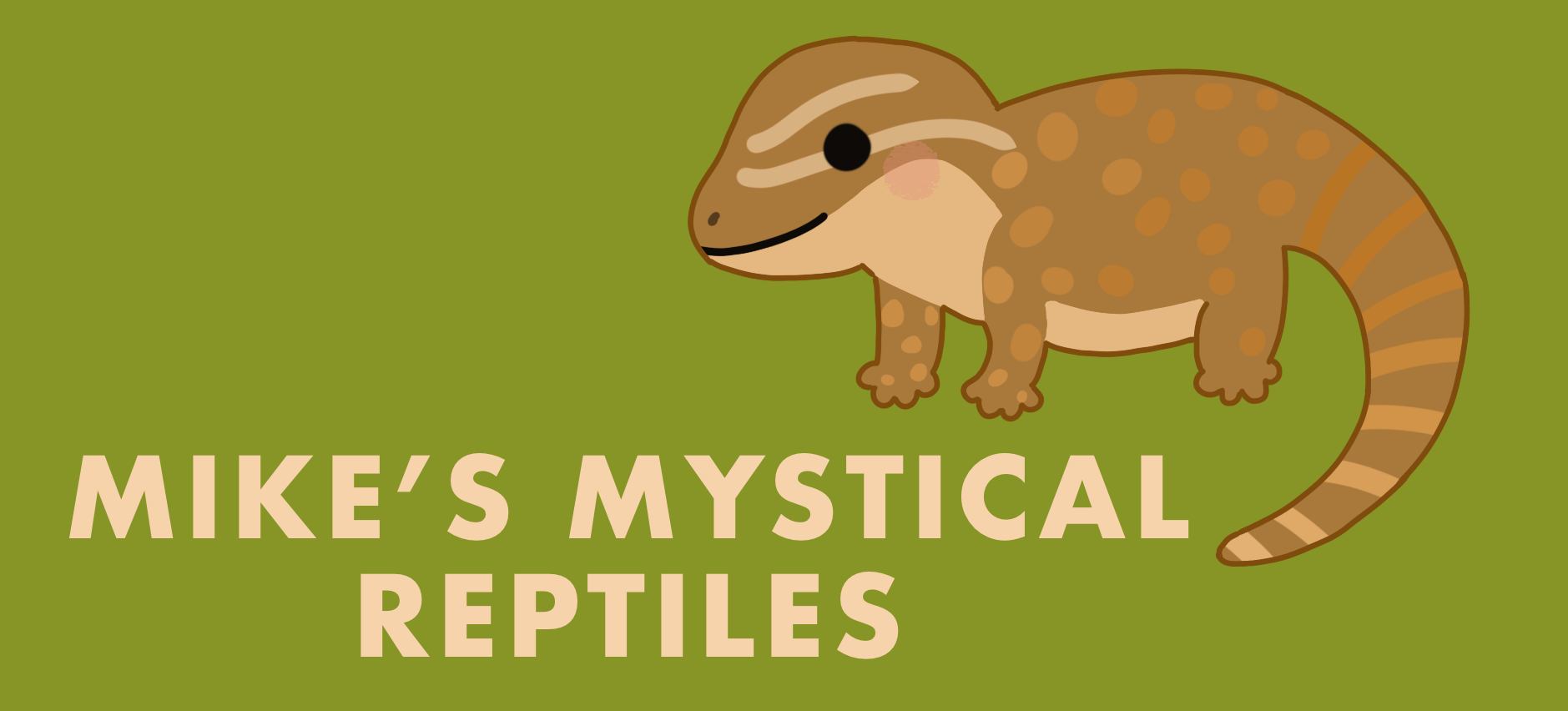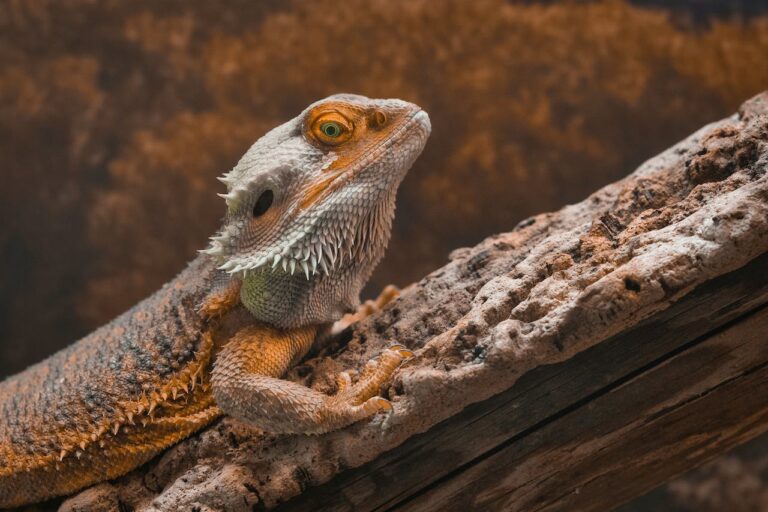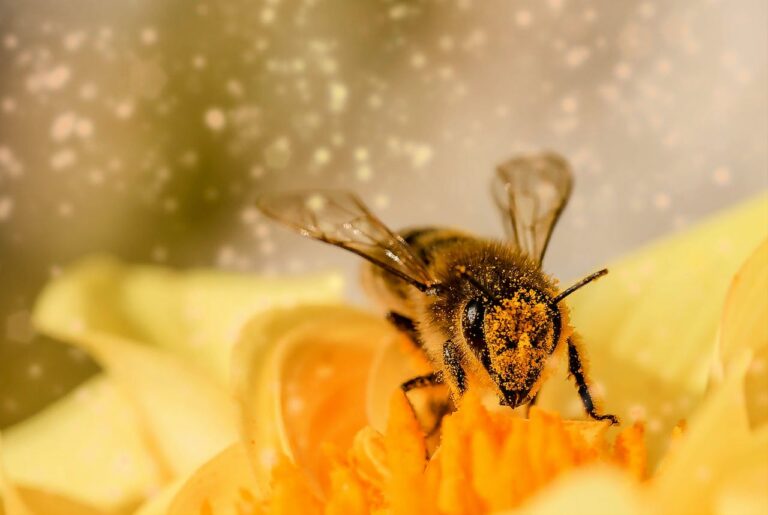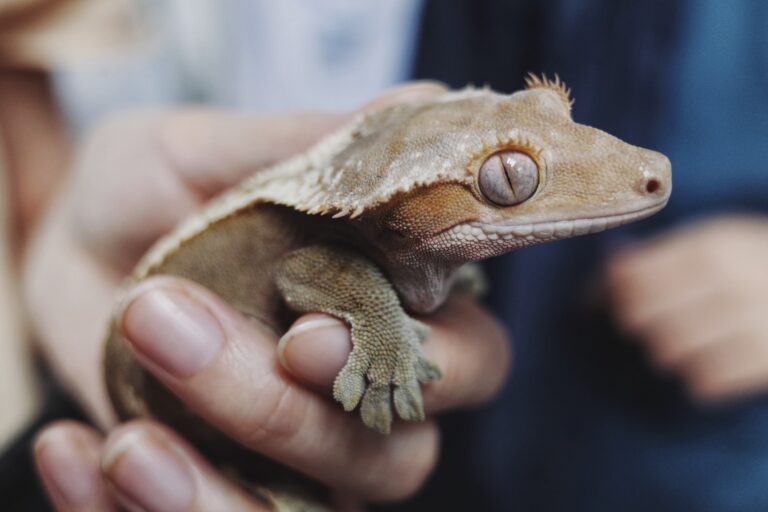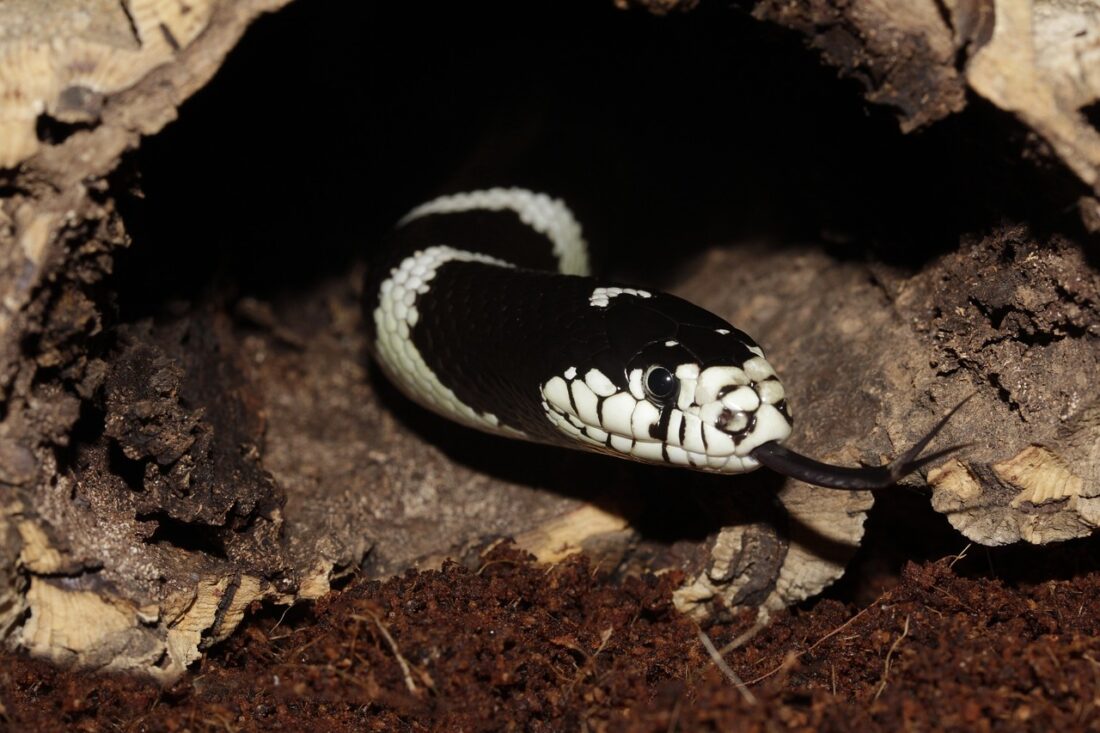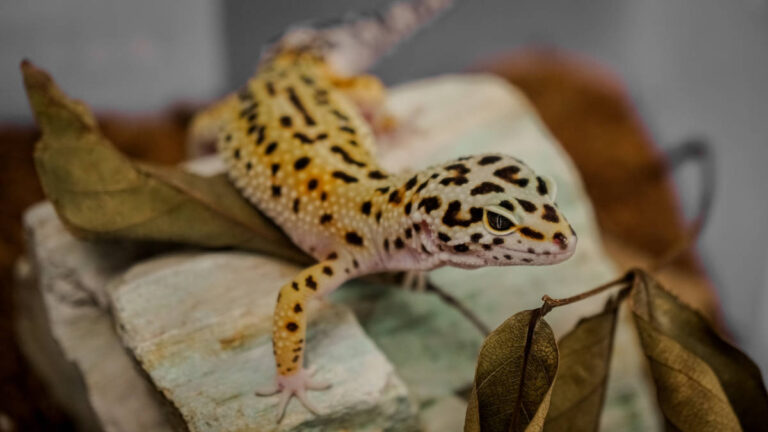Introduction
Do you want a reptile that will sit on your shoulder for hours just chilling while you do your work, check your emails, or watch TV?
If yes, consider getting a bearded dragon!
These fascinating creatures are not your typical pets (compared to say your dog or cat). However, with their unique behaviors, expressive personalities, and distinctive appearance, I would argue that they possibly make even better pets!
Bearded dragons make for incredibly rewarding companions. Besides the somewhat expensive upfront cost, their care is not too difficult.
Bearded dragons are known to be great beginner reptiles as they are very hardy, have relatively straightforward care requirements, and pretty much come out of the box super tame (in my opinion, though many would agree).
As a reptile enthusiast looking to get into reptiles, they pretty much check off all the boxes regarding what makes a great first pet!
As long as you extensively research their care requirements before taking them in, they will do fantastic in their new family.
Overview
Let’s first dive into some of the basics when it comes to bearded dragons:
Bearded dragons, scientifically named Pogona, are lizards native to Australia and have become popular pets because of their friendly behavior and unique appearance.
These reptiles have a distinctive “beard” under their chin that puffs up when they feel threatened or excited. Hence, the name “bearded dragon”.
Bearded dragons come in various morphs and colors, including brown, tan, and red, and they have spiky scales along their bodies, making them easy to recognize.
Natural Habitat:
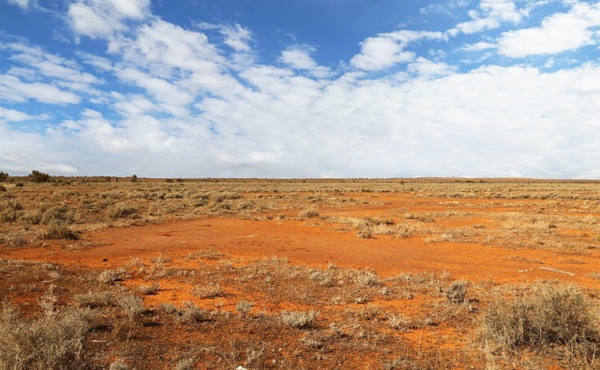
In the wild, bearded dragons are seen living in deserts, scrublands, and subtropical woodlands. They possess climbing and swimming abilities and are commonly seen basking on fence posts.
It is from their climbing nature that we discover that they are semi-arboreal rather than just terrestrial.
Their environmental temperature can fluctuate to different temperature ranges, from hot and sunny during the day to cooler at night. Knowing this is important so that we can best replicate their environment when it comes to raising one in captivity.
Size and Lifespan:
Bearded dragons are moderately sized lizards, growing to lengths of between 16 and 24 inches from head to tail, with 20 inches being about average. Keep in mind that males will typically get larger than females.
In addition, if your dragon is a German Giant morph, it will reach lengths of between 24 and 30 inches!
These lizards live relatively long lives, with the average now around 12-17 years. Good husbandry and care will impact their lifespan the most.
Growth Rate:
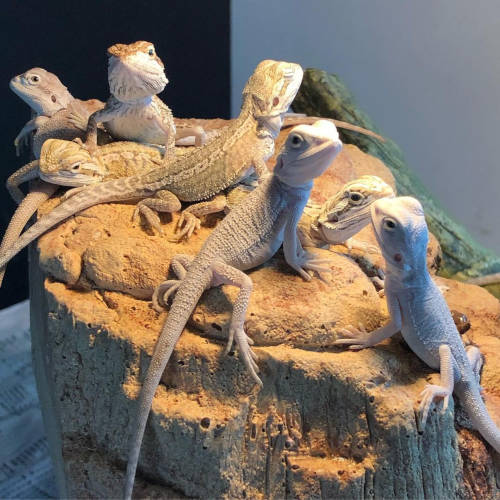
Bearded dragons grow fast! They can reach maturity at around 1 year of age and grow the fastest during their early years of life. The table below is just an estimate of how fast a dragon should be growing.
| Age | Length | Weight |
| Hatchlings | 2.5-4 inches | 2-6 grams |
| Babies (1-3 months) | 3-9 inches | 4-20 grams |
| Juveniles (3-12 months) | 9-16 inches | 20-300 grams |
| Subadults (12-18 months) | Female: 14-18 inches Male: 16-20 inches | 300-450 grams |
| Adults (18+ months) | Female: 16-19 inches Male: 19-24 inches | 350-500 grams |
I do want to point out that as adults, bearded dragons should not be that heavy. They should be lean and properly sized. The problem with many bearded dragons nowadays is that they are drastically overfed and thus become severely overweight.
If you are referring to the growth rate diagram, I would say that the lower end of the spectrum for adult dragons’ weights is more natural and optimal.
Mike’s Difficulty Assessment:
Taking everything into consideration, I give the bearded dragon a difficulty score of 5/10
I was tempted to give a lower score, but I had to take into consideration the more complex nutritional and dietary needs a bearded dragon required and its large enclosure size compared with other “beginner” reptiles.
Keep reading to learn why the bearded dragon deserved this score! 🙂
Habitat Setup
Setting up the optimal habitat and environment for your beardie will go a long way in ensuring it a healthy and thriving life!
Enclosure Size
The recommended minimum enclosure size for one adult bearded dragon is a 4′ x 2′ x 2′ (feet) enclosure (120 gallons). While babies and young juveniles may be okay living in the standard 40-gallon terrarium, I would highly recommend getting the 120-gallon from the start.
This will save you time and money down the road since your baby dragon will outgrow its 40-gallon enclosure in a matter of months and need the upgrade.
A common misconception is that baby bearded dragons are too small to live in a 120-gallon enclosure from the start. However, this is not the case. A baby dragon should have no problem accessing food and water in this size enclosure. In the wild, baby bearded dragons have an infinitely large enclosure and have lived perfectly fine like that.
Heating and Lighting
There are 3 main components (or types of light) when it comes to heating and lighting a bearded dragon’s enclosure. They are infrared light (heat), ultraviolet light (UVA and UVB), and visible light (LED is recommended).
The heating and lighting play a major role in the health of a bearded dragon and can be the difference between a weak, sick dragon and a thriving one.
If you’re curious, these three types of light are included in the electromagnetic spectrum! Learn more here.
Heating (Infrared Light):

Heating is just as important as UVB because, without heat, your bearded dragon would be unable to absorb vitamin D3 effectively.
We want the area under the basking bulb to have a surface temperature of around 104 to 107 degrees Fahrenheit.
This is several degrees higher than the optimal body temperature a bearded dragon should warm up to and provides some leeway for how much warmth the dragon can absorb.
To measure the surface temperature, I recommend investing in a temperature gun. It has a laser pointer and tells you the surface temperature of whatever the laser is pointing at.
I recommend using a 75 or 100-watt halogen or incandescent bulb to achieve this temperature. A halogen bulb will last a lot longer than an incandescent provided you don’t move the bulb around too much.
A recommended safe distance from the bulb to the basking surface is around 12 inches. To make sure it isn’t going to burn your bearded dragon, hold the back of your hand under the bulb. If it doesn’t burn, you’re probably fine. If it is too hot, you can just increase the distance between the basking zone and the bulb.
UVA and UVB:
UVA and UVB light play a huge role in a dragon’s health. In short, UVA helps facilitate reptile behavior such as feeding or body movement, and UVB allows reptiles to synthesize vitamin D3.
Studies have shown that bearded dragons are unable to absorb vitamin D3 in supplement form efficiently, so it is even more important to have a good UVB bulb in their enclosure.
Because all UVB bulbs contain UVA, we will be focusing primarily on UVB.
For UVB bulbs, I would use a long linear fluorescent bulb rather than a small coiled bulb, as the output for the coiled bulb is small, and has very little spread. The bulb length should be around 1/3 to 1/2 the length of the enclosure. For example, for a 4′ x 2′ x 2′ enclosure, use a bulb that is around 16 and 24 inches long.
Make sure you get the thinner T5-thickness fluorescent bulb rather than a T8, as the T5 is more efficient. Also, because bearded dragons fall into category 4 of the Ferguson zones (the highest category meaning they’re the most sun-demanding), they will require a UVB output of at least 10%.
Some options that have been tested and proven to work effectively are the Arcadia 12% UVB T5 HO and the Zoomed Reptisun 10.0 UVB HO (HO = High Output). The Arcadia lights are by far the best in the market and have different UVB strengths with each bulb (use 12% or 14% for bearded dragons depending on the UVI at the basking spot).
If you are confused about all the numbers, here’s how it works. The T numbers refer to the thickness of the bulb, with each T being an eighth of an inch. This means the T5 bulb is 5/8ths of an inch, and the T8 is 8/8ths or 1 inch.
The other number corresponds to the percentage of UVB that the light emits. For the Arcadia 12%, it emits 12% UVB, 30% UVA, and 58% visible light.
The basking area under the UV light should have a UVI index of around 4, as this was the average index found in bearded dragons basking in the wild. To measure this, you’ll need a UV meter, that measures the UV index in a given area. They can be very expensive but are well worth the investment in the long run.
The one I recommend that has been tested heavily is the Solarmeter Model 6.5.
Visible Light:

A good quality UVB bulb and basking bulb will keep your bearded dragon alive. But how can we help our dragons thrive and live the best quality of life? To do this, we should increase the brightness of the “sun” zone.
Bearded dragons, like most lizards, have a third eye, known as a parietal eye on the top of its head. This eye does not “see” like a normal eye would. Rather, it is used to detect the amount of light around (a built-in light dosimeter).
In the wild, this parietal eye helps bearded dragons wander to prime basking spots, as these areas usually have a greater power density (basically how strong the overall light is in a certain area). It could be hotter, brighter, and have more UV. This helps to regulate bearded dragons’ hormones and improve their sleep cycle.
How do we achieve this? I would install an additional LED light fixture next to the basking and UVB bulbs.
Final Notes:
Ensure that all 3 bulbs (UVB, heat, and LED) are placed close together on one side of the tank. In the wild, you wouldn’t have 2-3 different suns. You have one sun that produces heat, UVA/B, and visible light altogether.
This also provides your bearded dragon with a shaded side to retreat, encouraging natural behavior and supporting its circadian rhythm.
Temperature and Humidity
Bearded dragons are very hardy reptiles and can tolerate a wide range of humidities (from 10% all the way to 100%!)
However, the optimal humidity of a bearded dragon should be between 30 and 50%.
In the wild, bearded dragons may burrow deep underground in humid hideouts that may reach humidities close to 100%. Ambient air humidity could also increase temporarily at night or during thunderstorms.
The point is, that you rarely have to worry if your bearded dragon enclosure’s humidity becomes too high during the night or at any time. It is a natural fluctuation and as long as it isn’t long-term, it is alright.
The problem with too much humidity is that it allows bacteria and fungus to grow in the enclosure. A combination of too wet and too cold usually encourages this to happen. To prevent this, make sure the enclosure stays clean and that the humidity doesn’t get too high for too long.
As for temperature, the ambient air temperature should be around 85 degrees Fahrenheit around the basking area and between 75 and 85 degrees Fahrenheit on the cool side.
Substrate and Decor.
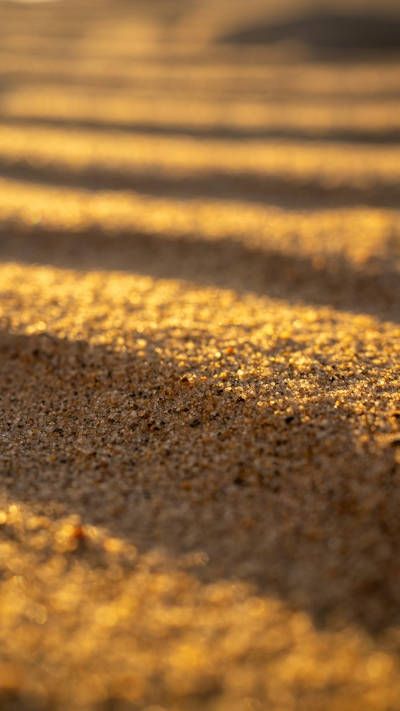
The subject of what substrate to house bearded dragons on is one of much debate.
Here’s my honest opinion.
If you have a healthy bearded dragon that is free of metabolic bone disease and properly hydrated, it should not get impaction, even if placed on a loose substrate.
Proper husbandry includes the heating, lighting, humidity, and diet of the dragon. If the bearded dragon has good husbandry, it has an extremely low risk of getting impaction from the substrate.
In addition, bearded dragons in the wild live on sand and are not getting impaction.
The benefits of loose substrate are many. Loose substrate allows bearded dragons to increase their muscle mass by letting them dig.
It also supports their joints and thus prevents arthritis in their later years from constantly jumping down on hard tiles or hard substrates (extends their life).
To achieve a substrate that allows for proper digging, burrow-holding capabilities, and plant life support, I recommend a mix of play sand, topsoil, and clay.
The play sand helps support digging activities and hold together burrows. Make sure you get play sand and not the types of sand that clump together (ex. calci sand: very bad and increases the risk for impaction as it encourages your dragon to consume it in dangerous amounts)
If you choose to use topsoil in your substrate blend, make sure that it is organic and free of any types of pesticides, fungicides, manure, or fertilizers.
You can experiment with different ratios and use different kinds of substrates. This is just what I found to work the best.
A fair warning that this substrate mix will require more maintenance, such as finding difficulty scooping poop on the substrate surface or requiring more frequent mistings to hydrate the top layer of the substrate. However, it is well worth it.
Because bearded dragons are semi-arboreal in the wild, they will appreciate a variety of climbing objects.
I would try to include logs of varying sizes, sticks, branches, or rocks. Have a few branches at a higher point in the enclosure so they have a high vantage point to see everything around them, simulating their wild environment.
Try to place the branches and cork rounds in places that will allow for possible burrow-making, as it will better simulate their natural habitat.
Consider placing a large flat rock under the basking area so that when the lights go out, the bearded dragon will still have a place to heat its belly for several hours.
Diet and Nutrition
We Feed Way Too Much
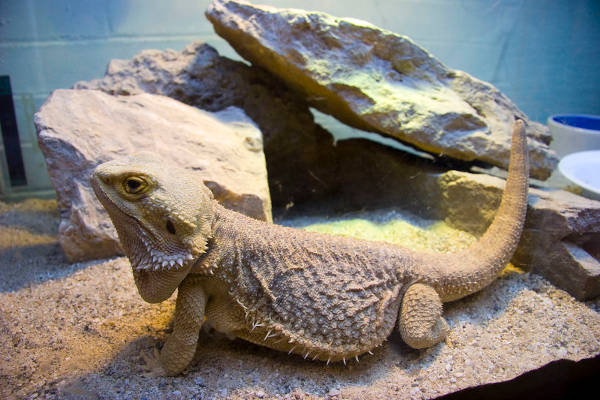
The truth is, bearded dragon owners simply feed their dragons WAY too much food. This is the reason why baby bearded dragons are growing into full-sized adults in just 6 months to a year. They should be growing to adult size naturally in around one and a half to two years.
When dragons grow that fast, they also need way more calcium than we usually give. Because they don’t have enough calcium for healthy bone growth, they are at a higher likelihood for weak, misaligned bones.
Reasons to Feed Your Bearded Dragon Less:
- Grow more naturally and healthily
- Healthy growth rate supports strong bones and fights against metabolic bone disease
- Enjoy the baby phase longer
- Cheaper
- Extends dragon’s lifespan
Bearded dragons need to eat FAR less than what most people think.
How Often to Feed
When bearded dragons are babies, feed them 4 to 6 appropriately-sized insects once a day. Follow this up with a bowl of greens once a day as well. The greens should be around the size of their head in total volume.
When they are juveniles or around 30 grams, still feed them a bowl of greens once a day, but scale back the insect feeding to once every other day.
As the dragons get even older and bigger, you can feed them insects every third day, while still feeding them greens every day.
An adult bearded dragon needs the least amount of insects. Feed an adult 4-6 insects twice a week and greens 3 times a week.
Our goal is to keep our dragons lean and healthy to support a healthy growth rate. If you see that your bearded dragon looking either too skinny or too plump, you can increase or decrease the number of insects during each feeding, or increase the number of feedings each week.
If you start feeding your bearded dragon less, you’ll start to realize how little food dragons actually require, and understand why so many bearded dragon pets are overweight.
What to Feed

For greens, I recommend feeding a diverse array of veggies, frequently rotating between the different types. You can consider feeding watercress, dandelion, clover, arugula, collard greens, romaine lettuce, kale, spring mix, rocket, nopales cactus pads, and more.
If you are looking to save some money and increase the diversity of greens, I would encourage you to forage plants for your bearded dragon. Just make sure they are free of any pesticides or sprays, and that your bearded dragon can safely eat them.
If your bearded dragon is reluctant to eat its greens, you can try feeding the greens before you feed the insects. These lizards naturally like the taste of insects more than the veggies. You can also feed them vegetable sprouts as they may appreciate the taste better.
Just be sure that the plants you feed are not high in oxalates, like spinach, since it will inhibit their calcium absorption.
On the topic of plant matter to feed, please do NOT feed bearded dragons fruit. There are so many reasons why this is a horrible choice. Fruits can cause dental issues and cause jaw bone loss if fed too often.
This is because bearded dragons don’t really have true teeth. They have what is known as acrodont teeth. They have a jaw bone that is serrated, that acts as teeth. As such, any decay or cavity directly affects their jaw bone.
While some people may say fruit is okay as a treat or once in a while, I would say to avoid feeding it altogether. Bearded dragons do not eat fruit in the wild, and will be much healthier without it.
For insects, rotate between crickets, dubia roaches, superworms, locusts, and other insects. The key is to provide variety to ensure your dragon is getting different vitamins and minerals in its diet.
Be aware of the size of the insects you are feeding to your bearded dragon. Ensure that the insect’s width is no longer than the space between the dragon’s eyes.
If you have an adult female bearded dragon, a good way to know if you are feeding too much is to see if she lays infertile eggs.
The reason many female bearded dragons in captivity lay infertile eggs is to help balance the overabundance of calories they are fed. A properly fed female bearded dragon should not have a need to ever lay infertile eggs. They will only lay eggs when mating.
Supplementation and the Importance of Calcium
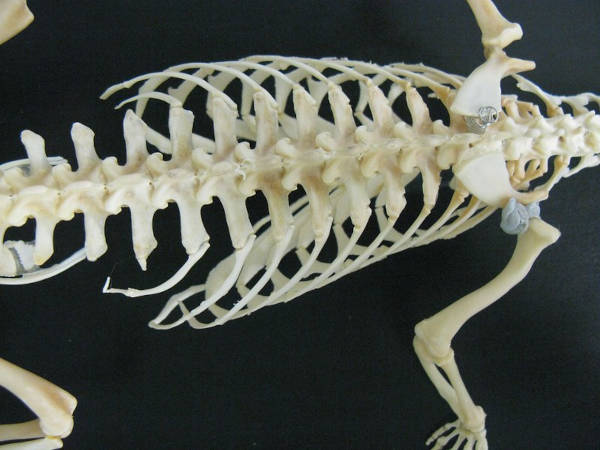
Calcium is very important in a bearded dragon’s diet. It helps promote strong bones and fights against metabolic bone disease.
Before you even begin thinking about whether or not you’re properly supplementing your dragons with calcium powder, it is important to get your UVB lighting and heating at optimal levels first.
Without UVB and heat, your dragon will not have sufficient vitamin D3 levels in their body. As a result, their digestive system will be unable to absorb any calcium.
A lack of calcium in a bearded dragon’s diet is more common than you think. The main reason for this is that the insects we feed them have tiny amounts of calcium and high amounts of phosphorus.
If a bearded dragon does not get enough calcium in their diet, they will begin to draw calcium out of their bones, leading to weak, curly-looking bones.
Bearded dragons need a 2:1 ratio of calcium to phosphorus. Because the insects they eat have exoskeletons that don’t contain any calcium, we must dust them with calcium powder. Don’t worry about possibly overdosing them on calcium as it is very difficult to do.
With the super-fast growth rate that most bearded dragons have in captivity nowadays, dragons may need higher ratios of calcium to phosphorus to support more bone growth (as much as 5:1). The solution? Grow your dragons a lot slower for healthier growth.
If your bearded dragon is showing signs of needing even more calcium in their diet, consider placing a small bowl filled with calcium powder in their enclosure. This will allow them to intake more calcium as often as they need.
If you’re wondering why bearded dragons in the wild don’t need to have calcium powder in their diet, it’s because the native plants they’re eating are very high in calcium to begin with.
As for other supplementation, you really don’t need to add more supplements, assuming you are feeding a diverse diet of greens and insects.
However, if you want to add multivitamins to their diet, I would say once every two weeks as a coating for the feeder insects would be ideal.
However, one supplement that I recommend all reptile owners use in their reptile’s diet is bee pollen. This natural supplement is a powerhouse of nutrients that will help ensure a much healthier bearded dragon.
Add a small pinch of it every week or as often as needed into their salads. If you want a more comprehensive guide about bee pollen, and its countless benefits for reptiles and all animals, check out this comprehensive guide I wrote here about it.
Behavior
Temperament / Handleability

In general, bearded dragons in captivity have a great temperament and tolerate handling exceptionally well! I would say they are one of the best pet reptiles if you are looking for a pet you can handle more frequently.
That being said, there may be cases where your bearded dragon may not come out of the box tame, and require some time to get used to your presence. This isn’t a training guide so I won’t go too in-depth. But you want to start by getting your bearded dragon merely used to your presence.
Bonding over giving them food from feeding tongs can help them understand that you are not a threat. My biggest tip for any skittish reptile is to be patient in their training.
On average, baby bearded dragons will be more skittish than their juvenile and adult counterparts. As time passes, they will become more calm and may appear to be somewhat lazy at times.
Bearded dragons are much smarter than what many people give them credit for. I would encourage anyone owning dragons to give them the best life possible and challenge their dragon’s mental cognition. The reason why many bearded dragons appear “dumb” is because they are not given any mental stimulation.
Taking them outside of their enclosure more frequently, incorporating treats inside chew toys, or changing up their habitat once in a while can go a long way to improving a bearded dragon’s cognition.
I would like to mention that male bearded dragons may become more aggressive during mating season, usually taking place right after brumation. In the wild (Australia), this could take place from around September to March, but in captivity, this usually takes place from March to June.
Males may head bob or flare their beard whether or not another male bearded dragon is around. This is usually nothing to worry about and you can treat their care the same way if you are not planning on breeding them.
Males also have something called femoral pores that excrete waxy substances for hormonal communication.
It is best to provide rough surfaces like rocks and branches so your bearded dragon can rub the substances off and avoid clogging the pores.
Potential Co-Habitation?
Bearded dragons should never be cohabitated unless you want to wake up to see one of the dragons smeared in blood across the glass of the enclosure (apologize for the mental graphicness; just a reminder of the potential consequences)
Expert herpetologists may be able to get away with housing two females in a massive enclosure (like 20′ x 10′ x 5′) but there is still a risk.
Bearded dragons hold territories of several hundred meters in the wild and it is simply impossible and unreasonable to try to replicate that in captivity.
I would personally never cohabitate bearded dragons as I don’t think the risk is worth taking.
Brumation
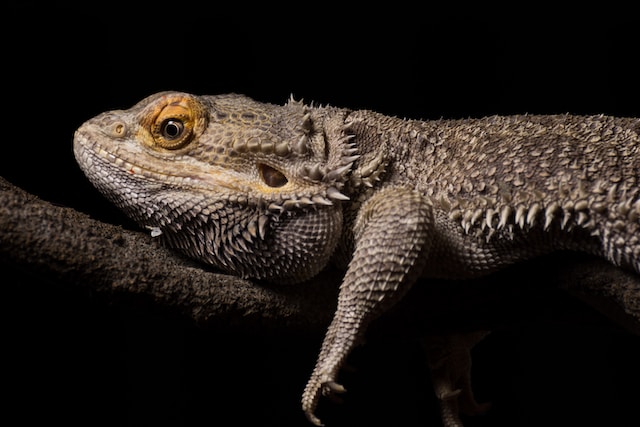
Like many reptiles, bearded dragons go into brumation during the winter times to survive the lower temperatures. They decrease their metabolism and body temperatures, stop eating, and “sleep” in deep burrows.
While there is still debate as to whether or not brumation is a true hibernation, I believe it can be thought of as a weaker form of hibernation.
So… What does this mean for our pet bearded dragons in captivity?
While some bearded dragons may not brumate, a majority in captivity still will, and it is important to be prepared.
If you are living in the Northern Hemisphere, your dragon may be brumating between the months of October to March. Yes, this is a wide range but most bearded dragons will not use all of this time, and just brumate for a few months or even weeks.
I do want to point out that if your bearded dragon appears to be going into brumation in the summer months and you are in the Northern Hemisphere, it may be going into a state of aestivation, rather than brumation.
Your bearded dragon is not remembering its bloodline roots all the way in Australia (a common misconception).
Aestivation arises when animals experience torpor (inactivity) due to a scarcity of food or water in high-temperature periods, a phenomenon commonly observed in species inhabiting deserts.
In this state, some creatures seek refuge in subterranean burrows to escape the intense heat and predators while in a sloth-like state.
Typically confined to the hottest part of the day, this condition serves as an effective strategy for energy conservation in environments where resources are often limited. In captivity, this can occur if the summer temperatures are exceptionally high and raise the ambient air temperatures in their enclosure as a result.
Here are a few signs that your bearded dragon is going into brumation:
- Reduced appetite
- Looking more lethargic, slow, or sluggish
- Increased irritability when trying to handle them
- Sleeping for longer periods of time
- Spending less time basking
- Retreating to colder areas
If your bearded dragon shows any of these signs for a continuous period of time and it entering winter time, there is a high chance it is going into brumation.
At this stage, it is important to make sure your dragon is healthy and does not have any parasites. If you are not completely sure your bearded dragon is not super healthy, you should consider taking it to the vet or requesting a fecal sample. (the fecal sample is just to make sure it does not have any parasites)
The reason why it is important that your bearded dragon is very healthy is it will be going for several months without food.
During this time, unsuspected internal parasites may cause the bearded dragon to lose dangerous amounts of weight, leading to sickness or even death.
The next step is to make sure your bearded dragon does not have any undigested food in its stomach, as it could lead to food rot, killing the dragon from the inside. Keep on the lookout for bowel movements and stop feeding.
You can also encourage bowel movements by placing them in warm water daily. Don’t be lazy as this could be the difference between a healthy and dead bearded dragon!
Okay, now what we want to do is decrease the number of hours of light/heat little by little until a certain point into the heart of winter. Then, we can start bringing up the hours of light/heat until the dragon is out of brumation.
Here’s an example lighting/heating strategy you can follow. Decrease daylight hours from 12 to 8 hours at mid-October all the while stopping feeding.
In November, decrease it even more to 6 hours. Keep it at 6 hours until mid-February, when you bring it back to 8 hours. Increase daylight back to the standard 12 hours a day the first day of March.
The reason we still give the bearded dragon some hours of daylight and heat even in the winter is to give the dragon a chance to bask if it wants to. A reminder that brumation may not be a true hibernation and the bearded dragon is just in a sleep-like, low-energy state.
Provide water in a bowl so that your dragon can hydrate. During this time, it is also recommended to decrease the air temperature to as low as reasonable.
A good target to aim for is around 60 degrees Fahrenheit. You may see your brumating bearded dragon basking during times when the air temperature is elevated during hot days in the winter.
Finally, here are some last notes on bearded dragon brumation. Don’t be too worried about your bearded dragon. Just keep monitoring them and their weight. As long as their weight doesn’t drop too much, it is perfectly fine. It is a natural process and it is our job as reptile owners to help them in this process the best we can.
Availability and Cost
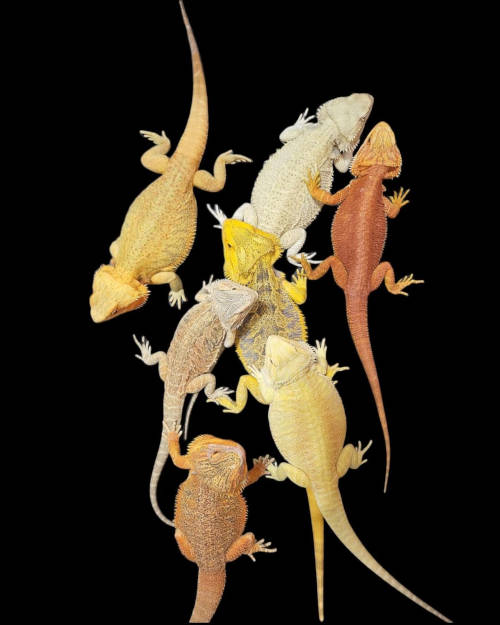
If you are interested in getting a bearded dragon as a pet, then there is good news!
Bearded dragons are readily available almost everywhere, including pet shops, exotic animal shops, and reptile shows!
For ethical reasons, I would highly discourage buying your bearded dragons from large pet store chains like Petco or Petsmart.
Instead, buy from reputable breeders that focus on the quality and health of your bearded dragon.
Additionally, you will have a much larger selection of bearded dragon morphs to pick from if you buy from a breeder. There are so many awesome ones out there!
The cost of a bearded dragon is very cheap in the world of reptile keeping. A standard hatchling bearded dragon should cost around 35$ on the low end if you get a good deal.
However, different morphs and colors will increase the price dramatically. About $100 is a good amount to consider spending if you want a bearded dragon with more colorful patterning.
You shouldn’t have to worry about buying captive-bred dragons as it is now illegal to import them from Australia. It doesn’t hurt to confirm with your breeder as to whether or not it is captive bred or not.
Before picking up your bearded dragon, make sure to ask the breeder what he/she has been feeding it, the substrate it is on (potential future impaction concerns), and how it was cared for.
Breeders and sellers should be happy to tell you how they keep them. If they seem to be hiding some information, I would not trust the quality of the bearded dragon, and I would go to a different breeder.
Finally, make sure a bearded dragon is even legal to own in your region. If it is illegal in your area, you will be unable to keep one even if you know you can care for it.
Before bringing your bearded dragon into its new home, make sure its enclosure is already set up. You want to make the transition from purchase to housing as smooth as possible. This also goes without saying, make sure you have done extensive research before purchasing your bearded dragon.
Health and Wellness
Bearded dragons, like all pets, require attention to their health and wellness to ensure a happy and fulfilling life.
This includes providing a suitable environment, a balanced diet, and regular monitoring for any signs of illness or discomfort.
If you provide the most optimal care for your bearded dragon, chances are that it will never have any sickness or disease, but it is still good to always monitor their health.
Regular Health Checks
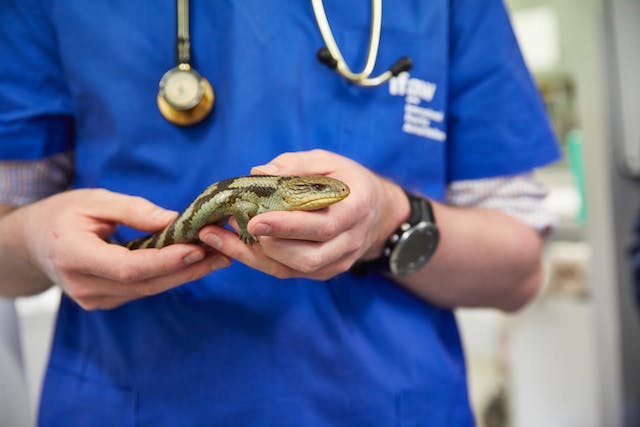
Regular health checks for bearded dragons involve observing their behavior, appetite, and physical condition. It’s important to monitor their eating habits, as a change in appetite can be an early indicator of health issues.
Additionally, checking their skin, eyes, and overall body condition is essential for detecting any abnormalities.
Common Health Issues
Bearded dragons are susceptible to various health issues, including metabolic bone disease, which can result from a lack of proper lighting and calcium in their diet. Respiratory infections, parasites, and shedding problems are also common.
Being aware of the symptoms of these issues and seeking prompt veterinary care is crucial for maintaining their health.
Behavioral Indicators
Understanding the behavioral indicators of bearded dragons is vital for assessing their well-being.
This includes observing their activity levels, basking behavior, and interactions with their environment. Any sudden changes in behavior, such as lethargy or stress, should be addressed promptly.
Veterinary Care
Veterinary care is an essential aspect of bearded dragon health. Finding a reptile-savvy veterinarian and scheduling regular check-ups is highly recommended.
A vet can provide guidance on diet, habitat, and preventive care, as well as diagnose and treat any health issues that may arise.
Beginner Suitability / Friendliness / Overall Difficulty

Overall, I would say the bearded dragon is a beginner-intermediate reptile.
I think it is a great first option for many reptile keepers IF they research the animal extensively and are prepared for its specialized care requirements.
I think the way most people are caring for bearded dragons makes them beginner reptiles, but caring for them properly and optimally results in a more challenging reptile that is so much more fun to own!
Frequently Asked Questions
Do Bearded Dragons Cuddle with Humans?
Bearded dragons, like many animals, each have their unique personalities. Some may love cuddling with their owners and some may not. As to whether or not they actually do it out of love, they probably do it because they feel more secure, and our bodies give them a soothing warm feeling.
If you are looking to find ways you can interact more with your bearded dragon, check out this article I wrote on 11 fun activities to do with your reptile!
What is the Difference Between Brumation and Hibernation?
There is a lot of debate as to whether brumation is the same as hibernation. I would say that generally, the term brumation is associated with a less intense hibernation. However, they are essentially the same.
Reptiles will go into a hibernation-like state (brumation) that can have frequent awakenings to drink water or bask, while mammals will hibernate for long periods on end, usually without waking up for the entire time.
How Long Can a Bearded Dragon Go Without Eating?
I would expect a healthy adult bearded dragon to be able to go without eating for several weeks up to several months if they are currently brumating. If they are not brumating, they will probably be okay for a week or so without food, as long as they have water available.
Baby bearded dragons are not as robust and may risk death if not given food for a week or longer. Bearded dragons are robust creatures and can tolerate a wide range of living conditions, even ones that are not suited to their lifestyle.
What Happens If Your Bearded Dragon Bites You?
Though bearded dragon bites are rare, they can still happen for reasons such as an intense food drive or aggression.
The size of the dragon will determine the severity of the bite, with larger dragons capable of giving more painful bites. However, bearded dragons have small teeth and will probably not inflict that much pain/damage on you.
If your bearded dragon bites you, make sure to disinfect the affected area to prevent any infection, and then bandage it up. It’s that simple. (Though you may want to investigate the cause of the bite. Did you aggravate the bearded dragon? Is it a male and it’s currently mating season? Doing this can help prevent future bites and develop a better relationship between you and your bearded dragon)
Do Bearded Dragons Recognize Their Owners?
Bearded dragons are much smarter than what most people give them credit for. The reason why they appear “dumb” and unresponsive is because they are usually not provided with the correct enrichment and stimulation for them to live thriving lives. (You most likely shouldn’t experience this if you follow my guide 🙂
Bearded dragons can recognize their owners through voice and scent, displaying comfort and familiarity. (maybe also facial recognition?)
While their affection differs from mammals, they may respond to their name, associating it with benefits like food or care. They show unique forms of affection, such as licking hands, responding to calls, or changing color to communicate.
Do Bearded Dragons’ Bite Hurt?
A bearded dragon’s bite typically does not hurt too bad. If your bearded dragon is a baby, it probably will not break the skin but larger dragons will be able to penetrate the skin layer and cause you to bleed.
A bite from a larger dragon will definitely hurt because of the tiny razor teeth and bite pressure, but it is very tolerable. (You will not want to make it a habit of being bit though lol)
Should I Soak My Bearded Dragon Every Day?
Bathing your bearded dragon daily is unnecessary. Typically, it’s recommended to bathe them every four to eight days, adjusting based on shedding or constipation issues.
Use water between 85 and 95 degrees Fahrenheit for 10-30 minutes, especially during shedding for skin moisturization. Supervise baths, and make sure your dragon is fully dried before returning to the enclosure to avoid substrate sticking to them.
Conclusion
Well… that’s the end of this comprehensive bearded dragon care guide! If you read through the whole thing, congratulations and thank you! I really hope you learned something new! You’re definitely on your way to becoming a bearded dragon carer expert!
Before we end, here’s a quick recap of what we learned:
- Overview
- Bearded dragons are lizards native to Australia that have become popular pets due to their friendly behavior and unique appearance.
- They have a distinctive “beard” that puffs up when threatened or excited.
- Come in various colors like brown, tan, and red with spiky scales along their bodies.
- Natural Habitat
- Found in deserts, scrublands, and subtropical woodlands in Australia.
- Possess climbing and swimming abilities.
- Temperatures fluctuate from hot and sunny days to cooler nights.
- Size and Lifespan
- Grow 16-24 inches long from head to tail. Males are larger than females.
- Live 12-17 years on average with good care.
- Grow fastest in early years, reaching maturity around 1 year old. Optimally should be 1.5 – years naturally.
- Enclosure
- Minimum 4′ x 2′ x 2′ enclosure recommended for adults.
- Requires proper heating (basking surface temp 104-107 degrees Fahrenheit), lighting {UVB (use linear fluorescent 10%-14%) and LED (just for brightness)}, and humidity between 30-50%.
- Varied substrate allows for digging. Include decor like branches/rocks to provide climbing.
- Diet and Nutrition
- Fed too much in captivity leading to fast, unhealthy growth.
- Babies: insects once a day, greens once a day.
- Juveniles/adults: insects every 2-3 days, greens daily.
- Rotate between nutrient-rich greens and insects like crickets, and roaches.
- Proper UVB lighting is critical for calcium absorption—dust insects with calcium powder.
- Behavior and Handling
- Generally have great temperament and tolerate handling well.
- Males can become aggressive during mating season.
- You should never cohabitate multiple dragons together.
- Brumate in winter by decreasing metabolism and temperature.
- Health
- Susceptible to metabolic bone disease, infections, and parasites if improper care.
- Monitor behavior, appetite, and body condition for abnormalities.
- Seek prompt veterinary care when issues arise.
- Beginner Reptile Suitability?
- Great for beginners IF properly researched beforehand.
- Requires some specialized care like lighting and nutrition.
- Caring optimally makes for a more challenging, engaging pet.
That’s it for this bearded dragon care guide! What is one new thing you learned today? Let me know in the comments section below! I’ll catch you in the next one 🙂
